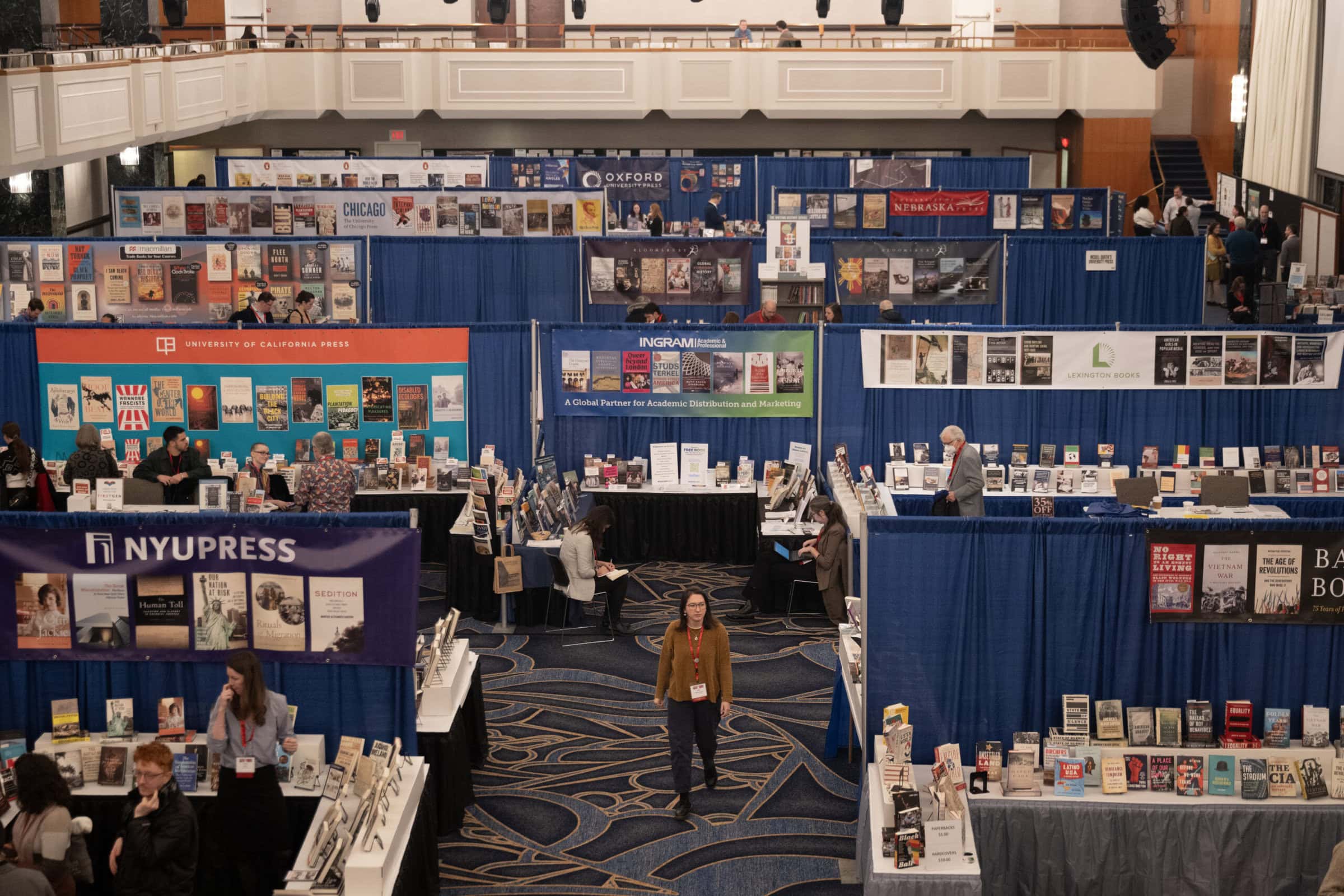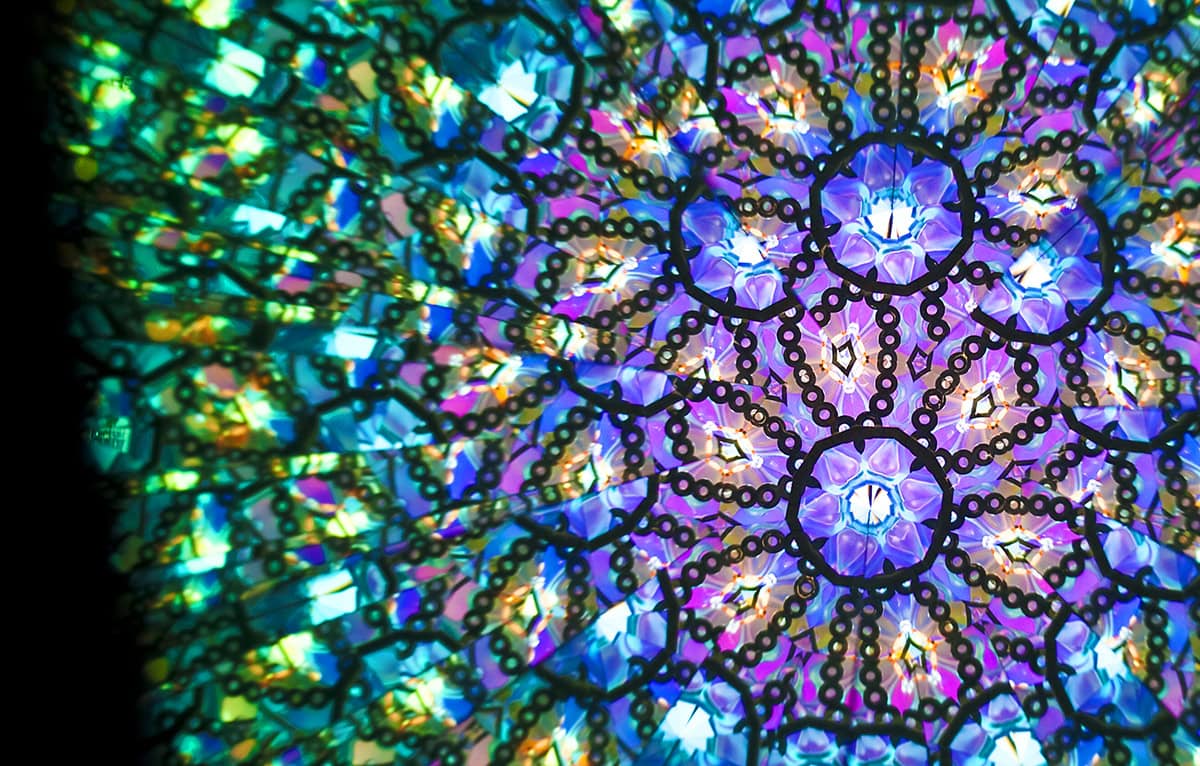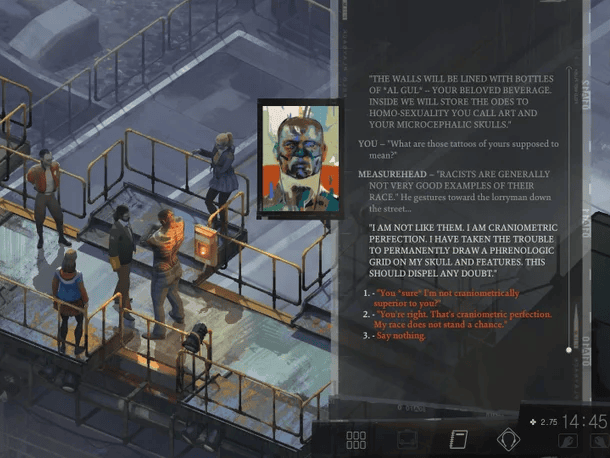One of the most exciting areas within the emerging field of multimedia computer-assisted education is the family of computer products grouped under the rubric of presentation software. These packages allow individuals with no experience in design to create multimedia electronic slide shows that are both highly polished and visually engaging. There are a variety of reasons for incorporating multimedia presentations into lectures. From a pedagogical point of view, the wipes, fades, and other animation effects possible with the new software are apt to catch the attention of students shaped by the visual aesthetic of MTV. From a scholarly point of view, multimedia teaching provides a means to showcase the enormous variety of sources routinely employed by historians. As history becomes increasingly interdisciplinary, historians will likely become more and more dependent on multimedia technology to present the full range of sources used in historical scholarship.
Teaching with multimedia demonstrates to students in an extremely compelling way that almost any artifact or document can be read for clues to understanding the past. It is possible to analyze literary texts, such as the Declaration of Independence, or read nontraditional texts, such as demographic data, political cartoons, paintings, architecture, or material culture. Multimedia teaching strategies are particularly effective in integrating the perspective of social history since multimedia makes it possible to present evidence of nonelite thought and behavior. Rather than focus solely on the perspective of the planter class, for instance, students can listen to slave spirituals. Even traditional political history can benefit from a multimedia approach. Cartoons and campaign songs can be juxtaposed with Senate speeches to provide a more complete account of political life. Recent developments in computer technology have simplified the logistics of assembling and customizing multimedia presentations in ways that were either impossible or prohibitively expensive with older technologies. At one level, the new technology merely brings together the equivalent of a slide projector, an overhead projector, a video projector, and an audio system in one computer program. There are, however, a variety of ways in which the new technology allows faculty to work more effectively than was previously possible. For example, it greatly eases the process of collaboration among faculty. Materials can be shared on a common storage device, and many individuals can have access to an archive of materials stored on a network, a hard drive, or even a CD-ROM.
The greatest asset of the new technology, however, is that it allows users to customize materials. Individual instructors can easily edit materials stored in the archive and adapt them to particular courses. A variety of software packages exists to help faculty edit visual, audio, and traditional texts. Using these packages, one can zoom in on part of a painting, mix together the dramatic parts of several different speeches, highlight important sections of a text, and create customized graphs, charts, maps, or schematic diagrams. Moreover, images—assuming they are within the public domain- -can be scanned and incorporated into presentations. Outlines can be done in a variety of engaging formats. Animation effects such as flying bullets, fades, wipes, or dissolves can be incorporated to jazz up the presentation of materials. In effect, the new software provides individual instructors with a team of designers and graphic artists. With absolutely no training in design, it is possible to assemble and present an enormous amount of data in an engaging and lucid manner. Most programs are capable of generating handouts that can be given to students or incorporated into customized note packets. In short, the use of multimedia software can greatly enhance the effectiveness of the traditional lecture format.
Basic Components
What follows is a general discussion of the various hardware, software, and “live ware” (faculty time) necessary to assemble a multimedia presentation. To get up and running with multimedia presentations, there are a few basic things one cannot be without.
1. Good equipment. If you will be developing and delivering materials in the Windows environment, make sure you have at least a 486 66Mhz computer with 8MB RAM. Also make sure that you have plenty of disk storage space. File sizes for a single multi media presentation lecture can easily reach the 10MB mark, so working with a series of floppy disks is out of the question. The most efficient way to deliver these types of materials (except video) is via a campuswide network. If you don’t have access to such a network, an external hard drive is your next best option. External hard drives are easy to transport and connect and can hold a number of different presentations. Drives in the 200-300MB range can be purchased for a relatively minimal cost these days. It is possible to create a portable multimedia cart containing all the hardware necessary to create and present materials. The cart can then be moved to various locations as needed.
2. Presentation software that will meet your teaching needs. Always keep your teaching goals and style in mind when shopping for a presentation software package and purchase only the software-hardware configuration that will help you implement those goals. A comparison of two popular presentation packages can help to illustrate these concerns. Microsoft’s PowerPoint 4.0 is a widely used presentation application, but it does have some potential limitations when used in an instructional setting. PowerPoint is organized in a linear fashion; the program is designed around the metaphor of an electronic slide show with sound and video overlays. It is difficult to move back and forth between different parts of a presentation and impossible to move between presentations. And once an audio track begins to play there is no way to stop the program from playing the prerecorded sounds. Nonlinear models of presentation are not easily assembled with this program. Yet, for illustrating a tightly formulated narrative, PowerPoint can be very useful.
The program Astound is better suited to nonlinear modes of presentation. It allows users to create on-screen controls and hyperlinks that provide the opportunity to improvise or change direction once a slide show has begun. One can move to other slides, graphics, sound files, audio CD clips, digitized video, and more. A nonlinear presentation would more closely resemble performance art in that a variety of different narrative lines would coexist and the faculty member could reassemble them in a variety of ways with the click of a mouse button. Another way of conceptualizing a nonlinear presentation is to think of a web of interconnected strands in which it is possible to jump from one region of the web to another with minimal effort. Clearly, some teachers will be more comfortable with the approach built into PowerPoint while others are more likely to appreciate Astound.
3. Good utility software. Scanning and image manipulation software, sound editing software, and a multimedia database application to locate and retrieve digitized materials are all essential. The complexity of creating multimedia presentations requires a good technical support staff capable of handling both hardware and software questions. As with any computer application, technical problems are bound to arise.
4. Time. Conceptualizing an existing course in multimedia terms can involve either enriching standard lectures with a few images, sounds, and video clips or completely reconceptualizing the course. If you merely wish to enhance a course that already exists by adding limited amounts of material to each lecture, plan to spend about half as much time as you would for a new course preparation. (This is assuming that a library of digitized materials, or materials that have been converted into a form that a computer can read, is available to you.) If, however, you will have to digitize sounds, scan graphics, create charts, or fundamentally recast the entire course, plan on spending double the time you would for a new course preparation. Fine-tuning digitized materials to create sharp-looking graphics and editing sounds to insure smooth transitions and segues can take many more hours than one might think. Incorporating materials in a way that would allow an entire lecture to take advantage of multimedia’s possibilities is a time-consuming process.
While the time devoted to assembling multimedia materials might seem daunting, it is important to look at the process of creating a multimedia library as a long-term project. Time spent collecting materials should be viewed as an investment since the library then becomes a resource that can be shared by colleagues in the same department or, for materials on the World Wide Web, in many departments. Also, it is possible, particularly if more than one colleague is working on the project, to divide up the burdens of locating materials.
Case Study: Multimedia and the American History Survey
Integrating multimedia technology into the existing American history survey course at Ohio State was a collaborative effort involving support from the College of Humanities and the history department.1 The initiative was designed both to train a member of the history department in the necessary technology and to begin building an electronic archive of multimedia materials. Without the backing of the graduate student research assistant provided by the history department and technical support from the College of Humanities’ newly created Office of Media Development, a project of this scope would have been impossible.
Several lecture halls at Ohio State were already outfitted with computer equipment and projection and amplification systems, and a connection to the campuswide network already existed. The only action required in order to use a multimedia presentation was to plug four cables from the computer into a wall control panel, turn on the system with a boot disk to the College of Humanities LAN, log into the account un der which the presentations were stored, and run the presentations. For smaller classrooms without dedicated projection systems, an active matrix LCD panel could be placed on an overhead projector and external speakers could be connected to the computer.
Supervising a graduate assistant, gathering materials, and conceptualizing a new multimedia version of the existing introduction to American history was time consuming. And converting my lectures into a multimedia format required the equivalent of a full-time course preparation. We began assembling materials for the multimedia version of the American history survey several weeks before the new term began. My first task was to train my research assistant to scan materials. The goal was to be at least two weeks ahead by the time term began. By the end of the term I was exactly one lecture ahead. The learning curve for the new software was steeper than I had expected, and the power of the new technology led me to try to include far more material than I had originally planned. The selection of materials was determined largely by the content of my lectures, but some materials were so engaging that I decided to incorporate several new themes into the lectures. Where period music was available to illustrate any themes in the course we always tried to include examples.
My original plan was to simply walk into class, plug the computer in, bring up my presentation, and start clicking the mouse. In practice, I spent a great deal of advance time with my teaching assistant figuring out what images and sounds would work to illustrate particular themes. It is important to emphasize that I relied heavily on overheads in the past and employed an informal style of lecturing, using materials on the overhead projector as the basis for presenting my lectures. Thus the transition to a multimedia presentation did not require adopting a completely different style of lecturing, but it was time consuming nonetheless.
The new technology helped solve the most pressing problem posed by lecturing to a large number of students: visibility. The standard overhead transparencies provided by most textbook companies are generally not legible beyond the third or fourth row of the lecture hall. Maps and charts are pastel blurs in the balcony. Even outlines of lectures done in 18- point type are difficult to read. The high-contrast templates available in the presentation software make the text of outlines easy to read, even in the balcony. The same is true for charts and images. Another problem that the new technology helped solve was the limited choice of materials available from textbook companies. Many of the images, maps, and other illustrative material in textbooks are not available even as transparencies for use in lectures. The glossy sidebars in texts that provide insight into architecture or the iconography of tombstones are of little use if they cannot be presented in a lecture. Scanning images from the text not only made them available, but also allowed me to annotate them with text and arrows, and even to zoom in on parts of them for closer inspection.
Commercial clip-art images, including maps and international flags, proved useful on a number of occasions. It was possible, for instance, to create custom maps to illustrate the important political compromises of the 19th century. Similarly, the flags of Britain and France were embedded in a slide to provide a means of visually reinforcing the differences between Jeffersonian and Federalist foreign policy. The graphing capabilities of the software proved especially useful in demonstrating how historians analyze quantitative data. Creating a three-dimensional color chart was a particularly effective way of analyzing raw data about the demographic and economic changes in American society on the eve of the American Revolution.
In a lecture devoted to the cultures of Africa, America, and Europe during the period prior to contact, I decided to locate examples of the different musical traditions of these continents. In addition to viewing the distinctive architectural and artistic styles of different civilizations, students could listen to the musical differences as well. It was possible to create a montage of effects to link the different sources together. Similarly, in a lecture on utopian movements in the 19th century it was possible to show students examples of Shaker furniture and play them examples of Shaker hymns.
Most textbook publishers have devoted little attention to the potential of multimedia presentation tools. As more faculty begin to use multimedia teaching tools it is likely that a wide range of materials will become available in CD-ROM format. When the images, charts, and outlines now available in textbooks and teaching guides are converted into a format that can be easily integrated into existing presentation software packages, the time and difficulty of creating multimedia presentations will be greatly reduced.
Historians have only just begun to think about the possibilities suggested by the new multimedia technology. To take full advantage of multimedia technology would probably require grappling with the implications of postmodernism for teaching history. While the historical profession has proven largely unreceptive to the high postmodernism of recent theoretical writing, understanding the pervasive postmodern sensibility of students shaped by MTV may prove indispensable if history is to be accessible to future generations of students.
A number of historians have called for a return to narrative, but far less attention has been devoted to the possibility of taking advantage of the demise of traditional narrative. The new technology might make it possible to create a pedagogy consistent with postmodern theory, a history lecture without a metanarrative. In such a lecturing environment, the polished verbal essay that many professors conceive to be the apotheosis of lecturing would give way to a new style more closely resembling improvisational performance art. In the meantime, there is much that can be done with multimedia technology that requires no epistemological challenge to mainstream historical notions.
Multimedia technology will not, of course, solve all of the problems history teachers face as they confront a generation of students with different epistemological assumptions and different notions of literacy. The tools provided by multimedia can, however, help teachers demonstrate to students in important new ways the enduring power of historical analysis as a way of understanding the world.
Tools
Here is a list of the software and hardware needed to create the multimedia version of the American history survey at Ohio State.
A. Development of Materials
1. Software. Microsoft PowerPoint 4.0 (located on a shared network drive); Image Assistant (for scanning images); Corel PhotoPaint (manipulation of scanned images); and Microsoft Sound System (for digitizing sounds from Audio CD).
2. Hardware. IBM-compatible PC with 486 66Mhz, 8MB RAM, 350 MB hard drive; dual floppies, CD-ROM drive; network card (running on a Novell LAN); Windows Sound System 8-bit sound card Sony external speakers; Trident Graphics Accelerator card SVGA .28 14″ color monitor; and HP ScanJet III scanner.
B. Delivery of Materials
1. Software. Microsoft Windows; Windows Media Player; and boot disk to log into account on Humanities LAN.
2. Hardware. Grid 486 66Mhz, 8MB RAM; 16-bit SoundBlaster sound card; network card; ceiling-mounted projection system; and wall-mounted stereo speaker system.
While this shopping list might seem daunting, most of the materials are likely to be found in any university environment in which computer labs are already established. Individuals interested in viewing a demonstration of the ideas discussed in this article can visit the following site on the World Wide Web: https://www.cohums.ohio-state.edu/history/demos/. Audio portions of the class presentations have been excluded from the World Wide Web demo because of potential sound-card problems.
Note
- Diane Dagefoerde assisted with the project by providing technical assistance and insights from her training in curriculum development. Saul Cornell focused on issues of how to use the technology to present the more important themes of American history covered in the first half of the survey course. In this section of the article, Cornell describes the project. [↩]
Saul Cornell is assistant professor of history at Ohio State University and Diane Dagefoerde is assistant director of media development for humanities information systems at Ohio State University.


